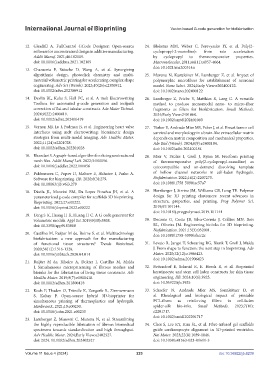Page 231 - v11i4
P. 231
International Journal of Bioprinting Vector-based G-code generation for biofabrication
12. Gleadall A. FullControl GCode Designer: Open-source 24. Bloksma MM, Weber C, Perevyazko IY, et al. Poly(2-
software for unconstrained design in additive manufacturing. cyclopropyl-2-oxazoline): from rate acceleration
Addit Manuf. 2021;46:102109. by cyclopropyl to thermoresponsive properties.
doi: 10.1016/j.addma.2021.102109 Macromolecules. 2011;44(11):4057-4064.
doi: 10.1021/ma200514n
13. Chansoria P, Rütsche D, Wang A, et al. Synergizing
algorithmic design, photoclick chemistry and multi- 25. Murenu N, Kasteleiner M, Lamberger Z, et al. Impact of
material volumetric printing for accelerating complex shape polymorphic microfibers for establishment of neuronal
engineering. Adv Sci (Weinh). 2023;10(26):e2300912. model. Nano Select. 2024;Early View:e202400122.
doi: 10.1002/advs.202300912 doi: 10.1002/nano.202400122
14. Devlin BL, Kuba S, Hall PC, et al. A melt Electrowriting 26. Lamberger Z, Priebe V, Matthias R, Lang G. A versatile
Toolbox for automated g‐code generation and toolpath method to produce monomodal nano- to micro-fiber
correction of flat and tubular constructs. Adv Mater Technol. fragments as fillers for biofabrication. Small Methods.
2024;9(22):2400419. 2024;Early View:2401060.
doi: 10.1002/admt.202400419 doi: 10.1002/smtd.202401060
15. Vernon MJ, Lu J, Padman B, et al. Engineering heart valve 27. Türker E, Andrade Mier MS, Faber J, et al. Breast tumor cell
interfaces using melt electrowriting: biomimetic design survival and morphology in a brain-like extracellular matrix
strategies from multi-modal imaging. Adv Healthc Mater. depends on matrix composition and mechanical properties.
2022;11(24):e2201028. Adv Biol (Weinh). 2024;8(9):e2400184.
doi: 10.1002/adhm.202201028 doi: 10.1002/adbi.202400184
16. Bhandari S. A graph-based algorithm for slicing unstructured 28. Mair V, Paulus I, Groll J, Ryma M. Freeform printing
mesh files. Addit Manuf Lett. 2022;3:100056. of thermoresponsive poly(2-cyclopropyl-oxazoline) as
doi: 10.1016/j.addlet.2022.100056 cytocompatible and on-demand dissolving template
17. Pakhomova C, Popov D, Maltsev E, Akhatov I, Pasko A. of hollow channel networks in cell-laden hydrogels.
Software for bioprinting. IJB. 2020;6(3):279. Biofabrication. 2022;14(2):2207270.
doi: 10.18063/ijb.v6i3.279 doi: 10.1088/1758-5090/ac57a7
18. Dávila JL, Manzini BM, Da Lopes Fonsêca JH, et al. A 29. Herzberger J, Sirrine JM, Williams CB, Long TE. Polymer
parameterized g-code compiler for scaffolds 3D bioprinting. design for 3D printing elastomers: recent advances in
Bioprinting. 2022;27:e00222. structure, properties, and printing. Prog Polymer Sci.
doi: 10.1016/j.bprint.2022.e00222 2019;97:101144.
doi: 10.1016/j.progpolymsci.2019.101144
19. Ueng S-K, Huang H-K, Huang H-C. A G-code generator for
volumetric models. Appl Sci. 2019;9(18):3868. 30. Decante G, Costa JB, Silva-Correia J, Collins MN, Reis
doi: 10.3390/app9183868 RL, Oliveira JM. Engineering bioinks for 3D bioprinting.
Biofabrication. 2021;13(3):032001.
20. Castilho M, Ruijter M de, Beirne S, et al. Multitechnology doi: 10.1088/1758-5090/abec2c
biofabrication: a new approach for the manufacturing
of functional tissue structures? Trends Biotechnol. 31. Levato R, Jungst T, Scheuring RG, Blunk T, Groll J, Malda
2020;38(12):1316-1328. J. From shape to function: the next step in bioprinting. Adv
doi: 10.1016/j.tibtech.2020.04.014 Mater. 2020;32(12):e1906423.
doi: 10.1002/adma.201906423
21. Ruijter M de, Ribeiro A, Dokter I, Castilho M, Malda
J. Simultaneous micropatterning of fibrous meshes and 32. Bettendorf E, Schmid R, E. Horch R, et al. Bioprinted
bioinks for the fabrication of living tissue constructs. Adv keratinocyte and stem cell laden constructs for skin tissue
Healthc Mater. 2019;8(7):e1800418. engineering. IJB. 2024;10(6):3925.
doi: 10.1002/adhm.201800418 doi: 10.36922/ijb.3925
22. Koch F, Thaden O, Tröndle K, Zengerle R, Zimmermann 33. Schaefer N, Andrade Mier MS, Sonnleitner D, et
S, Koltay P. Open-source hybrid 3D-bioprinter for al. Rheological and biological impact of printable
simultaneous printing of thermoplastics and hydrogels. PCL-fibers as reinforcing fillers in cell-laden
HardwareX. 2021;10:e00230. spider-silk bio-inks. Small Methods. 2023;7(10):
doi: 10.1016/j.ohx.2021.e00230 e2201717.
doi: 10.1002/smtd.202201717
23. Lamberger Z, Mussoni C, Murenu N, et al. Streamlining
the highly reproducible fabrication of fibrous biomedical 34. Choi S, Lee KY, Kim SL, et al. Fibre-infused gel scaffolds
specimens towards standardization and high throughput. guide cardiomyocyte alignment in 3D-printed ventricles.
Adv Healthc Mater. 2024;Early View:e2402527. Nat Mater. 2023;22(8):1039-1046.
doi: 2024. 10.1002/adhm.202402527 doi: 10.1038/s41563-023-01611-3
Volume 11 Issue 4 (2024) 223 doi: 10.36922/ijb.6239

